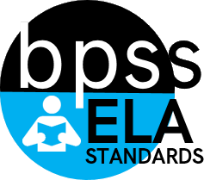ELA-11.RL.05
|
11th Grade ELA Targeted Standards
[RL] Reading Literature Strand
Cluster: Craft and Structure
ELA-11.RL.05 Analyze how an author’s choices concerning how to structure specific parts of a text (e.g., the choice of where to begin or end a story, the choice to provide a comedic or tragic resolution) contribute to its overall structure and meaning as well as its aesthetic impact.
|
Student Learning Targets:
Knowledge Targets
- I can define structure as how a story is organized.
- I can explain the different structural choices authors have when writing (e.g., subplot, parallel plot, flashback, foreshadowing, in medias res, sequence, multiple narrators).
- I can define comic resolution.
- I can define tragic resolution.
- I can define aesthetic.
Reasoning Targets
- I can insightfully analyze the author's structure and explain how this structure contributes to overall meaning.
- I can analyze how an author’s ideas or claims are developed by particular sentences, paragraphs, or larger portions of a text (e.g., a section or chapter).
- I can compare and contrast differences between poems, drama, and prose, and refer to the structural elements of poems (e.g., verse, rhythm, meter) and drama (e.g., casts of characters, settings, descriptions, dialogue, stage directions) when writing or speaking about a text.
- I can analyze how style and structure contribute to the power, persuasiveness, or beauty of the text.
Skills (Performance) Targets
Product Targets
- I can write a literary analysis essay that supports how structural choices contribute to the meaning of a work, and/or I can contribute to class discussion in a way that shows my understanding of how the author's structure complements meaning.
Proficiency Scale
| Measurement of Progress |
CRAFT & STRUCTURE
-
RL 11-12.4 Determine the meaning of words and phrases as they are used in the text, including figurative and connotative meanings; analyze the impact of specific word choices on meaning and tone, including words with multiple meanings or language that is particularly fresh, engaging, or beautiful (include Shakespeare as well as other authors).
-
RL 11-12.5 Analyze how an author's choices about structuring and relating different elements in the text (e.g., use of epilogues, prologues, acts, scenes, chapters, stanzas) contribute to meaning and aesthetic impact.
- RL 11-12.6 Determine purpose or point of view by distinguishing what is directly stated in a text from what is really meant (e.g., satire, sarcasm, irony, or understatement).
|
Sample Activity
|
| Advanced |
In addition to expectations of proficiency, the student demonstrates in-depth inferences and applications regarding more complex material that go beyond end of instruction expectations.
The student
-
insightfully analyzes meaning and impact of words and phrases and the effects of an author’s choices in structuring a text
-
thoroughly analyzes author’s point of view, cultural experience, and subtext.
-
connects study of literature, its craft and structure, and applies it to his/her own writing.
-
analyzes point of view, clearly distinguishing what is directly stated in a text from what is really meant, connecting usage to the author’s purpose.
|
- |
| Proficient |
The student demonstrates no major errors or omissions regarding any of the information and processes that were end of instruction expectations.
The student
-
determines the meaning of words and phrases as they are used in the text, including figurative and connotative meanings.
-
relates the author‘s word choice and language (including multiple meanings and language that is fresh and engaging) to the meaning and tone of the text.
-
closely examines specific parts of a text in order to understand how an author structured and crafted that particular part to contribute to meaning or artistic effect.
-
analyze point of view, recognizing when and why an author says one thing but means another.
|
- |
| Progressing |
The student demonstrates no major errors or omissions regarding the simpler details and processes but exhibits major errors or omissions regarding the more complex ideas and processes.
The student
|
- |
| Novice |
With help, the student demonstrates a partial understanding of some of the simpler details and processes and some of the more complex ideas and processes. |
- |
Resources
Websites
Vocabulary |

